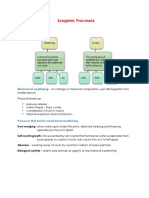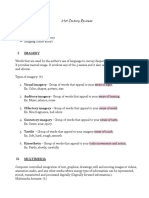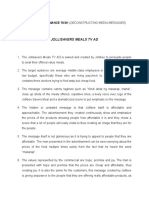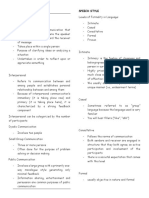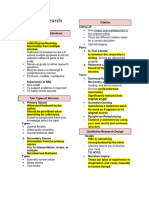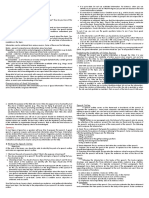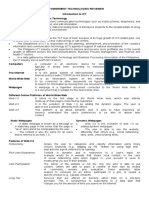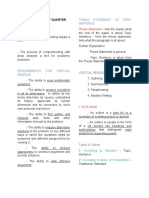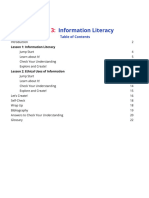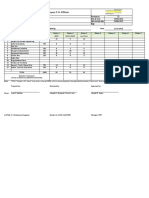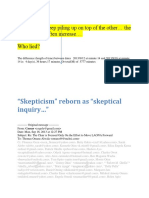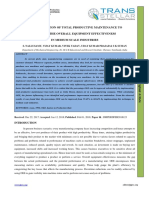Pointers Oral Comm.
Pointers Oral Comm.
Uploaded by
Rose Ann BereberCopyright:
Available Formats
Pointers Oral Comm.
Pointers Oral Comm.
Uploaded by
Rose Ann BereberOriginal Description:
Copyright
Available Formats
Share this document
Did you find this document useful?
Is this content inappropriate?
Copyright:
Available Formats
Pointers Oral Comm.
Pointers Oral Comm.
Uploaded by
Rose Ann BereberCopyright:
Available Formats
ORAL COMMUNICATION POINTERS
Communication is a process of sharing and conveying messages or information from one person to another within and across channels, contexts, media, and cultures.
NATURE OF COMMUNICATION
1. Communication is a process.
2. Communication occurs between two or more people.
3. Communication can be expressed through words, actions, or both at the same time.
ELEMENTS OF COMMUNICATION
1. Speaker the source of information or message.
2. Message the information, ideas, or thoughts conveyed by the speaker in words or in actions.
3. Encoding the process of converting the message into words, actions or other forms that the speaker understands.
4. Channel the medium or the means, such as personal or non-personal, verbal or non-verbal, in which the encoded message is conveyed.
5. Decoding the process of interpreting the encoded message of the speaker by the receiver.
6. Receiver the recipient of the message, or someone who decodes the message.
7. Feedback the reactions, responses, or information provided by the receiver.
8. Context the environment where communication takes place.
9. Barrier - the factors that affect the flow of communication.
MODELS OF COMMUNICATION
1. Shannon-Weaver Model depicts communication as a linear or one-way process consisting of five elements: a source, a transmitter, a channel, a receiver, and a destination.
2. Transaction Model a two-way process of communication with the inclusion of feedback as one element.
FUNCTIONS OF COMMUNICATION
1. Control communication functions to control behavior.
2. Social Interaction communication allows individual to interact with others.
3. Motivation communication motivates or encourages people to live better.
4. Emotional Expression communication facilitates peoples expression of their feelings and emotions.
5. Information Dissemination Communication functions to convey information.
FEATURES OF EFFECTIVE COMMUNICATION 7. Correctness (Things to consider when engaging Verbal Communication)
1. Completeness BARRIERS TO COMMUNICATION 1. Appropriateness
2. Conciseness 1. Emotional Barriers 2. Brevity
3. Consideration 2. Use of Jargon 3. Clarity
4. Concreteness 3. Lack of Confidence 4. Ethics
5. Courtesy 4. Noisy Environment 5. Vividness
6. Clearness VERBAL AND NON-VERBAL COMMUNICATION
DEFINITION AND NATURE OF INTERCULTURAL COMMUNICATION
Intercultural Communication is the sending and receiving of messages across languages and cultures.
DMIS Developmental Model of Intercultural Sensitivity
Stage 1. Denial the individual does not recognize cultural differences.
Stage 2. Defense The individual starts to recognize cultural differences and is intimidated by them, resulting in either a superior view on own culture or an unjustified high regard for the new
one.
Stage 3. Minimization Although individuals see cultural differences, they bank more on the universality of ideas rather than on cultural differences.
Stage 4. Acceptance The individual begins to appreciate important cultural differences in behaviors and eventually in values.
Stage 5. Adaptation The individual is very open to world views when accepting new perspectives.
Stage 6. Integration Individuals starts to go beyond their own cultures and see themselves and their actions based on multifarious viewpoints.
ORAL COMMUNICATION POINTERS
Communication is a process of sharing and conveying messages or information from one person to another within and across channels, contexts, media, and cultures.
NATURE OF COMMUNICATION
4. Communication is a process.
5. Communication occurs between two or more people.
6. Communication can be expressed through words, actions, or both at the same time.
ELEMENTS OF COMMUNICATION
10. Speaker the source of information or message.
11. Message the information, ideas, or thoughts conveyed by the speaker in words or in actions.
12. Encoding the process of converting the message into words, actions or other forms that the speaker understands.
13. Channel the medium or the means, such as personal or non-personal, verbal or non-verbal, in which the encoded message is conveyed.
14. Decoding the process of interpreting the encoded message of the speaker by the receiver.
15. Receiver the recipient of the message, or someone who decodes the message.
16. Feedback the reactions, responses, or information provided by the receiver.
17. Context the environment where communication takes place.
18. Barrier - the factors that affect the flow of communication.
MODELS OF COMMUNICATION
3. Shannon-Weaver Model depicts communication as a linear or one-way process consisting of five elements: a source, a transmitter, a channel, a receiver, and a destination.
4. Transaction Model a two-way process of communication with the inclusion of feedback as one element.
FUNCTIONS OF COMMUNICATION
6. Control communication functions to control behavior.
7. Social Interaction communication allows individual to interact with others.
8. Motivation communication motivates or encourages people to live better.
9. Emotional Expression communication facilitates peoples expression of their feelings and emotions.
10. Information Dissemination Communication functions to convey information.
FEATURES OF EFFECTIVE COMMUNICATION 14. Correctness (Things to consider when engaging Verbal Communication)
8. Completeness BARRIERS TO COMMUNICATION 6. Appropriateness
9. Conciseness 5. Emotional Barriers 7. Brevity
10. Consideration 6. Use of Jargon 8. Clarity
11. Concreteness 7. Lack of Confidence 9. Ethics
12. Courtesy 8. Noisy Environment 10. Vividness
13. Clearness VERBAL AND NON-VERBAL COMMUNICATION
DEFINITION AND NATURE OF INTERCULTURAL COMMUNICATION
Intercultural Communication is the sending and receiving of messages across languages and cultures.
DMIS Developmental Model of Intercultural Sensitivity
Stage 1. Denial the individual does not recognize cultural differences.
Stage 2. Defense The individual starts to recognize cultural differences and is intimidated by them, resulting in either a superior view on own culture or an unjustified high regard for the new
one.
Stage 3. Minimization Although individuals see cultural differences, they bank more on the universality of ideas rather than on cultural differences.
Stage 4. Acceptance The individual begins to appreciate important cultural differences in behaviors and eventually in values.
Stage 5. Adaptation The individual is very open to world views when accepting new perspectives.
Stage 6. Integration Individuals starts to go beyond their own cultures and see themselves and their actions based on multifarious viewpoints.
You might also like
- Handling Forensic EvidenceDocument57 pagesHandling Forensic EvidenceJuanNo ratings yet
- Kieran McKeown Auth. Marxist Political Economy and Marxist Urban Sociology A Review and Elaboration of Recent DevelopmentsDocument294 pagesKieran McKeown Auth. Marxist Political Economy and Marxist Urban Sociology A Review and Elaboration of Recent DevelopmentsFelipe Reyes VallejosNo ratings yet
- Oral CommunicationDocument4 pagesOral CommunicationJuliene Ermie Parel BerameNo ratings yet
- 1st Term - Oral Communication in ContextDocument12 pages1st Term - Oral Communication in ContextArvin Carlo SenadorNo ratings yet
- Oral Communication ReviewerDocument10 pagesOral Communication ReviewerReychel LunaNo ratings yet
- Oral Communication ReviewerDocument8 pagesOral Communication ReviewerLeonard Salvacion100% (1)
- Models of Communication (Linear Communication) ReviewerDocument35 pagesModels of Communication (Linear Communication) ReviewerJahscent De GuzmanNo ratings yet
- Perdev ReviewerDocument3 pagesPerdev ReviewerHannah RullodaNo ratings yet
- Exogenic and Endogenic Processes NotesDocument10 pagesExogenic and Endogenic Processes NotesMargaret SesaldoNo ratings yet
- 21st Century ReviewerDocument4 pages21st Century ReviewerMeljean MurilloNo ratings yet
- Oral Comm ReviewerDocument6 pagesOral Comm ReviewerLeila J OroscoNo ratings yet
- Oral Communication, Grade 11 Quarter 2Document5 pagesOral Communication, Grade 11 Quarter 2CassyNo ratings yet
- Reviewer For Quarter 1 - 1st Semester (Oral Communication in Context)Document7 pagesReviewer For Quarter 1 - 1st Semester (Oral Communication in Context)Gabriel Louis Guaño100% (3)
- Oralcom ReviewerDocument11 pagesOralcom ReviewerGweneth WajeNo ratings yet
- Chelsea Nicole Bitera - Module 11Document6 pagesChelsea Nicole Bitera - Module 11Chelsea NicoleNo ratings yet
- Empowerment Technology Topic Summary For QuizDocument2 pagesEmpowerment Technology Topic Summary For QuizAngelo DiyNo ratings yet
- ORAL COMMUNICATION - Q1 - W1 - Mod1 - Fundamental of CommunicationDocument11 pagesORAL COMMUNICATION - Q1 - W1 - Mod1 - Fundamental of CommunicationJerome Bautista100% (1)
- Elements of Communication Educational InfographicDocument1 pageElements of Communication Educational InfographicOBILLOS LOWELLANo ratings yet
- q2 Module 10 EmptechDocument13 pagesq2 Module 10 EmptechKhie MonidaNo ratings yet
- Gen. Math TMLHT q2 Week 6Document17 pagesGen. Math TMLHT q2 Week 6Analou AvilaNo ratings yet
- Lesson 2 InterculturalDocument30 pagesLesson 2 Interculturaljokarnyne udtog100% (1)
- Lesson 2 Online Safety, Security and Netiquette and Kinds of Online ThreatsDocument8 pagesLesson 2 Online Safety, Security and Netiquette and Kinds of Online Threatsjeremie mesinaNo ratings yet
- 1st Quarter Reviewer PhilosophyDocument6 pages1st Quarter Reviewer PhilosophyMeryl Borlaza MercadoNo ratings yet
- Group 5 Performance Task (Deconstructing Media Messages)Document4 pagesGroup 5 Performance Task (Deconstructing Media Messages)Ma. Rhona Faye MedesNo ratings yet
- 11 - Oral Communication (1st Quarter Examination)Document4 pages11 - Oral Communication (1st Quarter Examination)Ronalene Macatangay100% (1)
- Communication Models Lesson 3Document37 pagesCommunication Models Lesson 3Angel BalayongNo ratings yet
- Midterm Examination in Oral Communication (Humss 11-Pascal) : Bayugan City, 8502 CARAGA PhilippinesDocument2 pagesMidterm Examination in Oral Communication (Humss 11-Pascal) : Bayugan City, 8502 CARAGA PhilippinesChel MaglanqueNo ratings yet
- Oral Com Module 5Document9 pagesOral Com Module 5Christian Grace CatipayNo ratings yet
- Pointers To Review in P.E 11 1Document5 pagesPointers To Review in P.E 11 1Serenity Nicole MateoNo ratings yet
- 21st Pointers To Review Lesson 3 and 5Document42 pages21st Pointers To Review Lesson 3 and 5Victoria Pangilinan De GuzmanNo ratings yet
- Oral Communication in Context Types of Communicative Strategy Learning Competency 1: Employs Various Communicative Strategies in Different SituationsDocument3 pagesOral Communication in Context Types of Communicative Strategy Learning Competency 1: Employs Various Communicative Strategies in Different SituationsJaycel Ablir100% (1)
- DRRM 8Document24 pagesDRRM 8Elaine Mae G. EsqueroNo ratings yet
- Grade 11 - Oral Comm Midterm ExamDocument5 pagesGrade 11 - Oral Comm Midterm ExamMis TakeNo ratings yet
- 21st Century Reviewer - 2nd Quarter (1st Sem)Document12 pages21st Century Reviewer - 2nd Quarter (1st Sem)julaokrizhajaneNo ratings yet
- ET Quarter 2 Module 1 The Nature and Purposes of Online Flatforms and Applications-1Document33 pagesET Quarter 2 Module 1 The Nature and Purposes of Online Flatforms and Applications-1Vinz AlilingNo ratings yet
- Stage 1: Denial: Common Phrases That Learners Might Use at This Stage AreDocument5 pagesStage 1: Denial: Common Phrases That Learners Might Use at This Stage AresheilaNo ratings yet
- Philosophy Reviewer Lesson 1 4Document10 pagesPhilosophy Reviewer Lesson 1 4Ethan Dwayn H. ContrevidaNo ratings yet
- Pe 4TH Quarter Exam ReviewerDocument2 pagesPe 4TH Quarter Exam ReviewerHaitham TomawisNo ratings yet
- Day 4. Explaining The Dimensions of CommunicationDocument9 pagesDay 4. Explaining The Dimensions of CommunicationRussel Baya100% (1)
- Reviewer For Oral Communication: Grade 11 STEMDocument4 pagesReviewer For Oral Communication: Grade 11 STEMYanni SerenoNo ratings yet
- Definition and Nature of Intercultural CommunicationDocument20 pagesDefinition and Nature of Intercultural CommunicationBeverly Datu100% (1)
- EmpTech (Midterm Exam Reviewer) Grade 11 STEMDocument12 pagesEmpTech (Midterm Exam Reviewer) Grade 11 STEMEthan Erika BionaNo ratings yet
- Practical Research 1 ReviewerDocument5 pagesPractical Research 1 ReviewerPauleen Mamaradlo100% (1)
- Sourcing The InformationDocument4 pagesSourcing The InformationJenny EnrilNo ratings yet
- ELS Q2 Answer-Key-4 PDFDocument9 pagesELS Q2 Answer-Key-4 PDFTest Ting100% (1)
- Oral Communication GR11 ReviewerDocument2 pagesOral Communication GR11 Reviewerseulgi100% (2)
- Oral Communication Midterm ExamDocument4 pagesOral Communication Midterm ExamJayson CastilloNo ratings yet
- Emp Tech - ReviewerDocument4 pagesEmp Tech - ReviewerYianna SibayanNo ratings yet
- Empowerment Technology Midterm ReviewerDocument6 pagesEmpowerment Technology Midterm ReviewerPatrick RamirezNo ratings yet
- MIL 1st Quarter Lesson SummaryDocument5 pagesMIL 1st Quarter Lesson SummaryRalph Francis GonzagaNo ratings yet
- Effective Communication ProcessDocument24 pagesEffective Communication ProcessDan JamesNo ratings yet
- Personal Development EsP PD11-12KO Ia 1.1 EsP PD11-12KO Ia 1.2 Pascual JR., Bayani L.Document34 pagesPersonal Development EsP PD11-12KO Ia 1.1 EsP PD11-12KO Ia 1.2 Pascual JR., Bayani L.catherine siobalNo ratings yet
- Nat Oral ComDocument5 pagesNat Oral Comselwyn duroNo ratings yet
- EAPP REVIEWER 2nd QUARTERDocument8 pagesEAPP REVIEWER 2nd QUARTERREYES, Kyla Marie M.No ratings yet
- Fictional CountryDocument22 pagesFictional CountryDelfwoodAlacyangNo ratings yet
- Eapp - Quarter 1 - ReviewerDocument5 pagesEapp - Quarter 1 - ReviewerChricellFNo ratings yet
- Mil Unit 3Document22 pagesMil Unit 3Julie-Anne Batuigas LeoganNo ratings yet
- Principles and Basic Techniques of Image ManipulationDocument18 pagesPrinciples and Basic Techniques of Image ManipulationLordwally Vanessa Cuaresma BerdinNo ratings yet
- EmTech Q2 M2 Web-Pages-WYSIWYGDocument15 pagesEmTech Q2 M2 Web-Pages-WYSIWYGVicente priam AribonNo ratings yet
- MIL - Week 2Document10 pagesMIL - Week 2Aira Manuba MozoNo ratings yet
- DRRR ReviewerDocument6 pagesDRRR ReviewerJennacia SiguenzaNo ratings yet
- C06Document9 pagesC06Claire ElyseNo ratings yet
- Kanya PVS Catalogue 2008Document170 pagesKanya PVS Catalogue 2008james2271No ratings yet
- PART 1 - Describe A PersonDocument11 pagesPART 1 - Describe A PersonPhan ChiNo ratings yet
- Control Systems With Regard To Power Systems - RowleyBatten09Document40 pagesControl Systems With Regard To Power Systems - RowleyBatten09Rahul ChakrabartiNo ratings yet
- Hot Bolting Technical Bid Evaluation CriteriaDocument2 pagesHot Bolting Technical Bid Evaluation Criteriashahbaz1979No ratings yet
- Thomas Balmès's Chronicle of Four Babies - The New York TimesDocument3 pagesThomas Balmès's Chronicle of Four Babies - The New York TimesFurkan UçarNo ratings yet
- Difference Between JSP Include Directive and JSP Include ActionDocument9 pagesDifference Between JSP Include Directive and JSP Include Actionrobingarg_professionalNo ratings yet
- (Pamantayang Pangnilalaman) : Balik-Aral Sa Nakaraang Aralin At/o Pagsisimula NG AralinDocument9 pages(Pamantayang Pangnilalaman) : Balik-Aral Sa Nakaraang Aralin At/o Pagsisimula NG AralinDONA FE SIADENNo ratings yet
- "Skepticism" Reborn As "Skeptical Inquiry "Document4 pages"Skepticism" Reborn As "Skeptical Inquiry "Anonymous tBodA9NiNo ratings yet
- Rubric For Lab Report CHM083Document1 pageRubric For Lab Report CHM083Hana The Pencil KnightNo ratings yet
- Exercise 1Document3 pagesExercise 1Inoka RasanjaleeNo ratings yet
- Mikel Hoffman Field Observation Report Visit 4 5-6-14Document3 pagesMikel Hoffman Field Observation Report Visit 4 5-6-14api-243298110No ratings yet
- 123 Ijmperdfeb2018123Document12 pages123 Ijmperdfeb2018123TJPRC PublicationsNo ratings yet
- D. Idealism: Professional Education With RationalizationDocument15 pagesD. Idealism: Professional Education With RationalizationDivine Grace JasaNo ratings yet
- Cultural GeographyDocument14 pagesCultural GeographyMarcia Lopez100% (1)
- 3 Seed Year Pocket CalendarDocument24 pages3 Seed Year Pocket CalendarSerge Slayky100% (1)
- AASHTO BoltsDocument5 pagesAASHTO BoltsCyrilNo ratings yet
- Chemical BondingDocument19 pagesChemical BondingAnjali Rakhyani0% (1)
- Hipparchus of NicaeaDocument10 pagesHipparchus of Nicaeaapi-263310904No ratings yet
- Passion Project RubricDocument2 pagesPassion Project Rubricapi-351772547No ratings yet
- AADE Review of Lost Circulation Materials and Treatments With An Updated ClassificationDocument9 pagesAADE Review of Lost Circulation Materials and Treatments With An Updated ClassificationMuhamad IrfanNo ratings yet
- Autocad Model Space and Paper Space Layout ViewDocument9 pagesAutocad Model Space and Paper Space Layout ViewIsmet MehmetiNo ratings yet
- Race For The Galaxy RulesDocument12 pagesRace For The Galaxy RulesJonathan BarelNo ratings yet
- Supplemental EISDocument207 pagesSupplemental EISatguintuNo ratings yet
- Draft EO - Repealing EO 65 BOD of Local Water DistrictsDocument27 pagesDraft EO - Repealing EO 65 BOD of Local Water DistrictsBernardo DelimaNo ratings yet
- Olivier BusinessMath 2018ADocument723 pagesOlivier BusinessMath 2018Acllew100% (4)
- Assignment 3 - QuestionsDocument4 pagesAssignment 3 - QuestionstekellamerZ aka tekellamer0% (1)
- Critique of Ryoji Ikeda SuperpositionDocument2 pagesCritique of Ryoji Ikeda SuperpositionalisebelNo ratings yet
- S.y.b.sc Cbcs Time Table 2024-2025Document1 pageS.y.b.sc Cbcs Time Table 2024-2025prakash.chikte7No ratings yet








